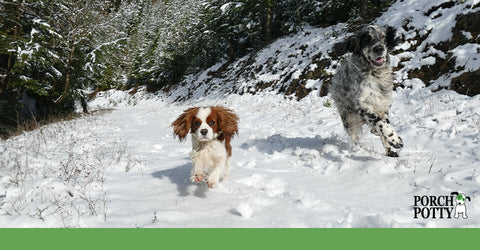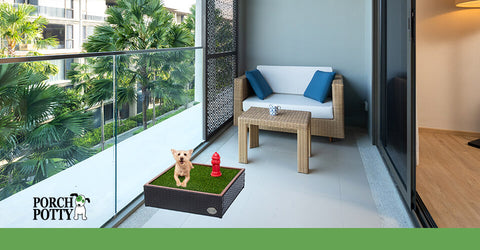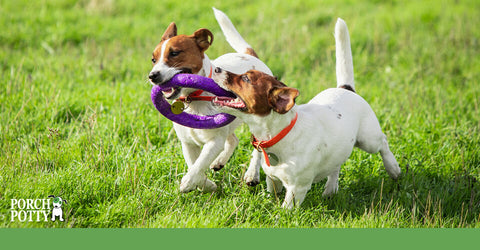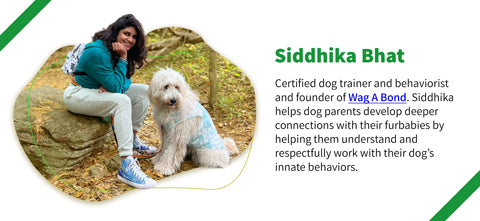
Two dogs run side by side through the snow.
House breaking or transitioning a dog from one designated spot to the other is not the rocket science it is made out to be. The trick is to make the transition gradual. There are two important steps one must remember in this process – preventing accidents as much as possible and rewarding every win. With consistency, positive reinforcement and the right training aids, a dog’s transition from Porch Potty to outdoor potty can be seamless.
Brief Overview of the Porch Potty
Porch Potty is one of the most convenient, clean and sustainable enablers for dogs to go potty indoors. By being accessible to dogs 24/7 inside the house, it makes it easier for them to use it as and when they need to, thereby eliminating the need for pet parents to take them out on multiple walks and in unfavorable weather. It is the perfect solution for urban dog owners.
Will a dog get too accustomed to the Porch Potty and resist going outside?
There is no denying the fact that habits can be hard to break in dogs, especially if they’ve been practiced long enough. The convenience that the Porch Potty provides can spoil dogs and dog parents to an extent. Transitioning a dog from Porch Potty to going outdoors to relieve themselves may depend on multiple factors such as:
- Age of the dog
- How long the dog has been using the Porch Potty
- How comfortable the dog is outside
- If the dog currently uses both indoor and outdoor options to relieve themselves
- Outdoor weather conditions
- Pre- and post-potty behaviour that the dog engages in
Resistance to change is going to be a part and parcel of the transition process. The longer a dog is used to a certain routine, the longer it may take to change. This is because they not only get accustomed to the surface of the Porch Potty, but also the indoor environment, the routine that leads them up to the Porch Potty and the convenience that comes with it.
Understanding Dog Behaviour
Understanding the factors that influence your dog’s bathroom habits will help you navigate the process of potty training and transitioning better. There are several factors that dictate a dog’s preferences and habits, such as:
- Preference towards certain surfaces such as grass, mud, hard floor, rugs etc. These surface preferences are generally determined by the environment the puppy is raised in the kind of access he gets to them
- Environment makes a huge difference in forming bathroom habits. Some dogs prefer a little privacy and isolation while relieving themselves whereas some are comfortable in an environment with more hustle and bustle.
- Association with the area is another factor that can encourage or discourage a dog towards a designated spot. If the dog feels rewarded while eliminating in a certain area (not necessarily with treats), they may continue to do so. On the other hand, if a dog has been reprimanded or has developed a negative association with a particular area, they may avoid eliminating in those areas.
- Familiar scent acts as an attractant for dogs because they thrive on predictability and familiarity. If your dog has previously peed on certain surfaces, they’d be naturally inclined to go back to it.
- Natural instincts are one of most crucial influences of dog behaviour and habits. Dogs instinctively choose to eliminate in areas that make them feel safe and have no potential threats. In the wild, they do not soil where they eat or sleep. This instinct is a part of every dog, regardless of where they live
- Lastly, routine is something that can help a dog adapt to their living conditions and dictate bathroom habits. If we do not set a routine for them, they will end up setting it for themselves.

A small Yorkshire Terrier lays down on a Porch Potty situated on an apartment balcony.
Benefits of Porch Potty in Potty Training
One of the most important things Porch Potty brings to the table is convenience, for both dogs and dog parents. Dogs tend to learn a behaviour or get accustomed to a routine faster if it is easy for them to perform. The ease of access that Porch Potty accelerates the potty training process and yields long lasting results. Furthermore, it is easy to set up, clean and move around, which only makes life easier for the pet parents.
Regardless of the weather outside, Porch Potty allows dogs to have a consistent potty area. This is particularly beneficial during extreme weather conditions when going outdoors may be less appealing for both dogs and owners.
It is an ideal solution for apartment dwellers, senior dogs, dogs with mobility issues, puppies and people who are unable to take their dogs outside frequently.
Testimonials
Tiana Levin, a happy Porch Potty customer, says, “We live in a high rise, and before we got our new puppy, we thought that it would be a good idea to have your product for emergencies, bad weather, and so we received it a few days before we got our puppy. I really had no intention of introducing him to it until he had settled in for a few days, and did his business outside on the grass. I thought that I would take him out on the balcony to become familiar with it, and so Bentley looked at it, walked the length of our balcony, came back, got onto the Porch Potty with no coaxing or my lifting him onto it, and did his business as if he had used it a thousand times - I was astounded at how easily he understood what it was for. For people who live in a high rise building, this is a Godsend for those times when your pet needs to relieve himself immediately, and you can’t wait for an elevator, or when it is raining, or freezing cold. Thank you for a wonderful product.”
Transitioning from Porch Potty to Outdoor Potty
Take your dog outdoors more frequently during the day
Increasing exposure to the new designated spot is a crucial step in transitioning your dog from indoors to outdoors. The more exposure your dog gets to the outdoors and the more easily accessible the area is, the faster the transition process will be. Depending on how many times your dog uses the Porch Potty to pee or poop, increase the frequency of going outdoors.
Understand your dog’s body clock and set a routine accordingly
Pay close attention to your dog’s body clock and make a note of the number of times they need to pee/ poop during the day as well as the times of the day they relieve themselves. Build a routine around it and take diligently take your dog outdoors around that time. Make sure to take your dog out after meals, water intake, naps, play, first thing in the morning and last thing before going to bed.
Taking your dog’s body clock and preferences into consideration and setting a schedule around it would make the transition process a lot quicker and smoother. Do not rush into it and be patient, especially if your dog is older.
Positive reinforcement is key
Positive reinforcement is one technique that has no down sides to it. Rewarding your dog for the smallest wins will accelerate the learning process and yield long lasting results.
Make sure to reward your dog with treats every time they pee or poop in the right spot. To help them understand better, reward them for stepping out willingly every single time and being at ease in their designated spot. This will also build positive association around the area.
Make your dog’s scent available in the new spot
Nothing makes dogs feel more at ease than familiar scent. Making it available outdoors will quickly help them transition from indoors to outdoors. A trick to do so is carrying the turf of the Porch Potty outdoors during the initial transition phase. If you have a backyard, consider moving the Porch Potty outside. If not, just take the fake grass patch and lay it on the area your dog is expected to pee on.
The enzymes on the grass patch will attract your dog and will help them relieve themselves faster.
Supervise closely to prevent accidents indoors
One of the most absolute ways of learning in dogs is repetition. The more they repeat a behavior, the more they remember it and the faster they learn it. This applies to both desirable and undesirable behaviors. Thus, if your dog keeps having accidents in the house or continues to pee on the porch potty in the transition process, it is going to be difficult for them to adapt to relieving themselves outdoors.
Make sure to prevent accidents to the best of your ability. The initial phase may demand more time and energy investment, but it will all be worth it when you see results. Closely monitor your dog and use a leash to take them outside immediately when they communicate signs that they need to pee/ poop.
Gradually start restricting access to the Porch Potty
Restricting access to the Porch Potty is a part and parcel of preventing accidents and accelerating the transition process. If your dog continues to have access to the Porch Potty, they will keep waiting to get back home to use it or will feel no need to step outside whatsoever.
However, do not cut off access all at once as that might overwhelm your dog. The best way to do so would be to take them out at times when they absolutely need to pee, such as early in the morning, evenings etc. and restrict access to PP at that time. Meanwhile, continue giving them access to the PP for a few hours during the day.

Two Jack Russell Terriers run and play outside, carrying a purple chew ring.
Tips and Tricks for Encouraging Outdoor Bathroom Habits
Encourage your dog to play outside
Playing offers a variety of benefits in terms of potty training a dog. It gets their system going, thereby encouraging them to relieve themselves faster and more frequently. It also releases happy hormones like dopamine, endorphins, oxytocin and serotonin, which help make a dog feel at ease in whatever environment they are in. Feeling comfortable in the new environment is crucial for them to relieve themselves.
Select a spot that makes your dog feel at ease
Several dogs prefer isolation, privacy and an area away from distractions while relieving themselves. For this reason, they may continue to walk to a quieter spot or wait till they come back home to pee or poop. When selecting a designated spot outside, make sure to take your dog’s environment preference in consideration.
Make a variety of surfaces available to your dog and let them take their pick
Surface preference is a common element of potty training. When transitioning, most dogs prefer to find a surface that matches the previous surface. However, certain factors like familiar scent on another surface, quieter environment, etc. could act as exceptions to this rule. During the initial transition phase, make sure to expose your dog to a variety of surfaces and let them take their pick.
Troubleshooting
“My dog waits to come back home and just does not pee outside.”
This is a very common problem faced by pet parents in the initial phase of transition. The older the dog, the longer this issue may last. A quick way to deal with it would be to keep the leash on your dog even after they come back home and monitor them closely. If your dog has been outdoors for quite sometime, they may most likely want to relieve themselves as soon as they come back home. When you see these signs, grab the leash and immediately walk your dog outside and encourage them to pee. Do not let your dog out of sight after coming home from a walk as that is when they are likely to have an accident.
“Can I train my dog to pee both indoors and outdoors?”
If you live in a city that is prone to unpredictable or harsh weather conditions, training your dog to pee both indoors and outdoors is an ideal option. However, this is more plausible in case of young puppies whose bladder control is not at full capacity. In case of older dogs, who have better bladder control, this option may be challenging to deploy as they may have already gotten accustomed to a designated spot/ surface and may not prefer relieving themselves in two different places.
Porch Potty is designed to make life easier for pets and pet parents. Sometimes, it tends to do the trick too well. Having said that, dogs are one of the most adaptable mammals in the world. They are capable of understanding over 220 human commands and are adept at communicating with them. With a gradual approach, consistency, a robust routine and positive reinforcement, dogs can be trained to adapt to a new bathroom schedule in good time. For further support, ask away your questions in the comments below and join the party at our forums! We’d love to hear from you.
Siddhika Bhat, Certified dog trainer and behaviorist and founder of Wag A Bond.
For more information on training your dog, check out these articles:
Conquer the Cold: Simplifying Winter Potty Training with Porch Potty




